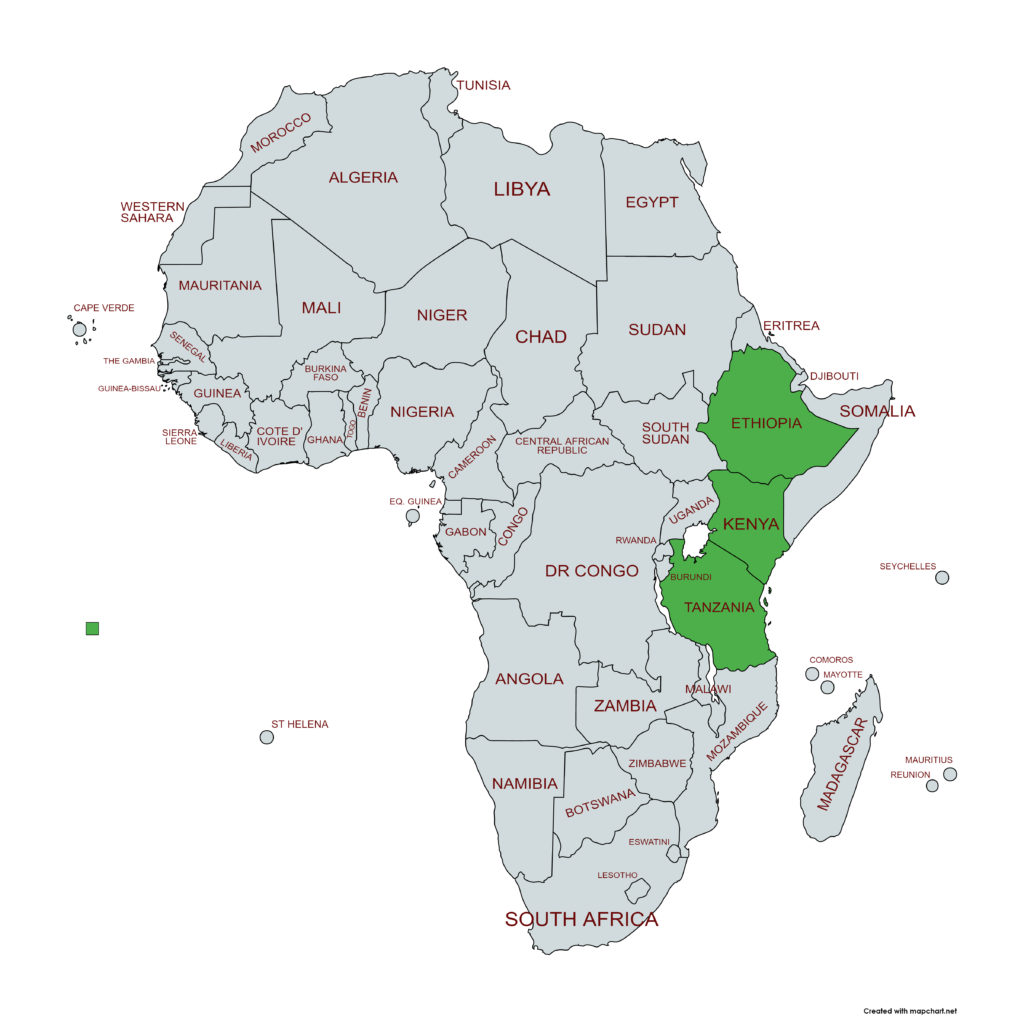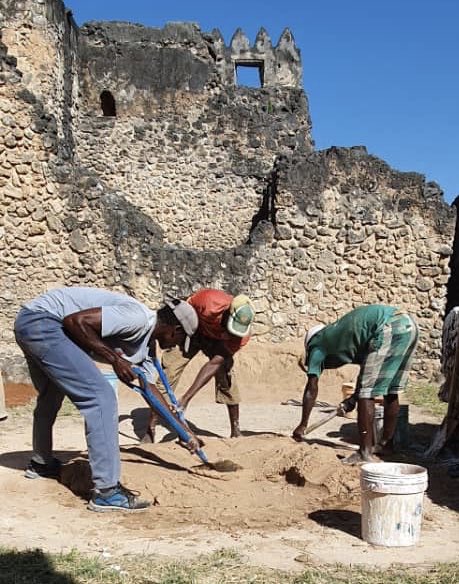
The UNESCO World Heritage site of the Ruins of Kilwa Kisiwani and Songo Mnara is located to the south of Dar es Salaam on the coast of Tanzania. In the 13th century, the site was an important Muslim centre and today the remains of the palace, the grand mosque and merchant trade centre stand in ruins close to a shoreline that is increasing impacted by our changing climate. The site also contains a less ruinous Portuguese fort standing proud against the encroaching sea near to where the local community beach their fishing boats for safety and repair. Unlike better known World Heritage sites around the world, such as The Pyramids of Giza or the Great Wall of China, the Ruins of Kilwa Kisiwani and Songo Mnara has not received the attention, and hence funding, to provide long-term protection.
Maritime Research
The project began in 2014 with colleagues from the University of Dar es Salaam (UDSM) with British Institute in East Africa and National Geographic Society grants to search for evidence of marine trade from the Middle East and India along the east African coast. The project also aimed to assess the fragility of the sites to a range of factors from climate change to human impacts. The marine geophysical surveys showed several locations of potential wreck sites and follow-up diving confirmed that one was a 13th century wreck.
Impact of the Research
The funding provided by the Scottish Funding Council (SFC) allowed us to further investigate the wreck and at the same time build local capacity by training divers from across Tanzania in underwater archaeological techniques. This project also allowed us to engage more fully with the local community through a series of outreach events such as information days and providing tours for local schools. As a result, we worked more closely with the community and started a process of mutual learning. A step change in engagement, however, came with the recording of a musical video sung by a popular Tanzanian “rap” artist, Claudia Lubao, and composed by our academic archaeological partner, Dr Elgidius Ichumbaki, at UDSM. The song highlighted the importance of heritage with a connection to local people and contained a message about the impact of climate change to the sites and the environment surrounding them. The release brought widespread attention to the plight of the site that other methods of promotion just could not have achieved. The local community were given a voice about their heritage and the Tanzanian Government began to pay attention.
Digital Databases
At a national level, Tanzania, like many east African countries, did not have a national database to help preserve and protect both tangible and intangible cultural heritage. Our work demonstrated a need for this type of database and the Government recognised a desire for it. In 2018, the SFC funding was used to build the first National Digital Heritage Database for Tanzania and to begin training academics and Government heritage officers on its use. The database has been fully accepted by the Tanzanian Department of Antiquities Ministry of Natural Resources and Tourism. Through workshops, online training and the research, a need was recognised for during the project for developing a mobile application for recording data and in 2020, the British Council sponsored its development and deployment (the app exists on the Android platform only currently). The app went live in 2021 and is now one of the main methods for recording cultural heritage and uploading this information to the database.
COVID-19
In 2020 as the world entered lockdown and movement in country ceased, a decision was made to accelerate a part of the program that involved building a community museum at Kilwa Kisiwani. Work began in early 2020 and, with local support, was finished by the end of that year. The museum attracted an extensive local interest with donations from the community of both tangible heritage, such as unknown artefacts, and intangible heritage, in the form of associated stories and songs. The Government now took an even keener interest and the Ministry of Natural Resources and Tourism accepted responsibility for the museum in an official opening where the Vice Chancellor of the University of Dar es Salaam handed over the museum to the regional Director of Antiquities. Most of the 3,000 visitors to date (in part due to continued travel restrictions) have been local residents learning about a heritage, as one local visitor puts it, “I did not know we had”.
Kilwa Kisawani museum is handed over to the Ministry of Natural Resources and Tourism by the Vice Chancellor or UDSM
Entrepreneurial Activities
The fragility of tangible cultural heritage is clear when vegetation encroaches buildings or when foundations are washed away by the sea, but threats to intangible cultural heritage are not so easily visible. Intangible cultural heritage, such as the stories of our past, the songs sung, the craft practices are not always recognised either as defining a past or who we are or from where we have come. However, they define people and give resilience to society. During the Tanzania project, two heritage enterprise women’s groups and a boat building group have been supported in their accumulation, practice and entrepreneurial use of traditional skills to build sustainable businesses. The project has been able to record the heritage, and the groups have built thriving businesses for over 60 people.
Enterprise groups at work with traditional crafts
Beyond Heritage
The impact of these sequence of events ripples much further than just local people learning about their past. With the community and Government working together, the site has been cleared of litter from onshore and no longer spills into the ocean. The high tide is no longer marked by plastic bottles. Impact of the work has progressed to benefit the whole environment. With the coastal waters kept clean, the surrounding reef will benefit and already tourism is increasing – Kilwa is becoming a place attracting visitors. Cleaner waters and a local community that is caring offers the opportunity for education about ocean pollution, fishing practice, reef damage, over-fishing, and the possibilities of a healthier, more economically sustainable blue economy. The Government has invested in walkways around the monuments at Kilwa and new tourist facilities –features that will increase the attractiveness of the site for both Tanzanian and foreign tourists.
The Future
This project began with academic research but through organic growth, it developed into a model for sustainable, resilient communities that demonstrates the value of cultural heritage and the equal partnership of all stakeholders. A return far beyond its modest investment has been realised. The ocean has provided the cultural backbone and economic prosperity to coastal communities for millennia; it is vital that its protection must be at the heart of future blue economy and sustainable living.
National Maritime Museum
Upscaling the project with the construction of a National Maritime Museum could increase impact multiple fold. A project plan is underway to convert the Old German Boma at Bagamoyo to a community hub with museum, accommodations, teaching/training facilities and research infrastructure. A similar initiative, at a smaller scale, was undertaken from 1997—2001 at the Boma in Mikindani. Here, Trade Aid (a charity based around UK trade business) supported the renovation to a hotel that is now self-sustaining to support training in the local community. This model with Scottish business support could make a substantial impact in east African communities.
Associated SFC GCRF funded projects on the St Andrews research portal
- SFC GCRF 2019-20
Digitizing Cultural Heritage for Sustainable Preservation and Development in Tanzania - SFC GCRF 2018-19
Safeguarding heritage for sustainable development in coastal sites










